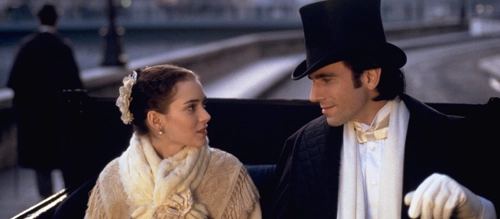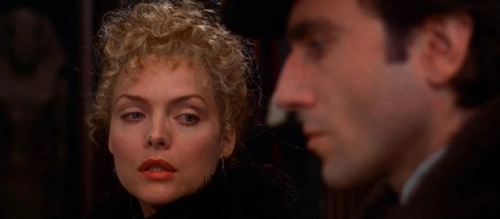‘The Age of Innocence’ at 30 – Review

The Age of Innocence (1993)
Director: Martin Scorsese
Screenwriters: Jay Cook, Martin Scorsese
Starring: Daniel Day-Lewis, Michelle Pfeiffer, Winona Ryder
Martin Scorsese is a prolific filmmaker, known for making movies infused with violence and passion, filled with characters who live outside of the law and the rules of society. From classic gangster pictures like Goodfellas to movies about corruption like The Departed, to the violence of Taxi Driver and the unrestrained wealth, privilege and power in The Wolf of Wall Street, Martin Scorsese has made a career out of exploring the extremes of human nature, the catharsis of explosion. In a lot of ways, The Age of Innocence, released in 1993, is an outlier in Scorsese’s filmography. It is not about acting with abandon, but about restraint, discretion and control. It is not about the mean, dirty streets of New York and the bowels of society, but instead about high society, about people trapped in very beautiful, gilded cages, desperate to scream, yet unable to. In other ways, The Age of Innocence is, in Scorsese’s own words, the most violent movie he has ever made.
Adapted from Edith Wharton’s classic novel of the same name, The Age of Innocence stars Daniel Day Lewis as Newland Archer, an affluent lawyer caught between his impending marriage to the respectable, mild-mannered May Welland (Winona Ryder) and his desire for her cousin, Countess Ellen Olenska (Michelle Pfeiffer). Set in the 1870s, during a time in the United States of great economic growth, industrialization, and a growing divide between the new world and the old often referred to as the Gilded Age, The Age of Innocence explores a world of rituals and class. The film was a great success for Scorsese, proof of his emotional intelligence and range as a filmmaker. It received numerous accolades, including the Oscar for Best Costume Design and the BAFTA for Best Actress in a Supporting Role for Miriam Margolyes. In Scorsese’s hands, The Age of Innocence is a masterclass in visual cinema, more than your typical costume drama, one of the best page-to-screen adaptations of all time.
Like the rose that blooms in the center of the screen in the beginning of the film, The Age of Innocence is beautiful – until it draws blood. Scorsese uses the color red throughout the movie as a kind of shorthand for romance, desire, and destruction. It’s bold and searing, much like Michael Powell and Emeric Pressburger’s The Red Shoes (1948). Red velvet drapes hang from the walls, signifying that a dinner party and a blood bath are essentially the same thing to these wealthy society folk. The color also plays a substantial role in the costuming as well. When Ellen makes her social comeback at a party hosted by the extremely wealthy Van der Luydens (Alexis Smith and Michael Gough), she does so in a form fitting red silk dress. Ellen is the embodiment of the desires Newland tries to ignore. She is unconventional, trying desperately to rebel against a rigid, unforgiving society. In contrast, May is typically dressed in white, highlighting her innocence and her unblemished reputation.
But there is something sinister lurking beneath May’s naïve, soft-spoken exterior. Winona Ryder’s performance is deeply layered and probably one of the most complex in the film, which no doubt contributed to her earning an Oscar nomination for Best Supporting Actress. There is something hidden behind May’s wide-eyed, girlish face, something knowing and intuitive. While Newland continuously describes May as being young and impressionable, Ryder is subtly steering us in a different direction. What she says is not what she means, and Ryder is able to capture that dissonance effortlessly – where her character ends up in the end is the most satisfying bate and switch. Day-Lewis and Pfeiffer are deliciously tragic in their mutual pining for one another. Their obvious romance, their painful longing, puts every modern onscreen pairing to shame. It would be easy to see May and Ellen as mere archetypes rather than real people, and they are to a certain extent, but Ryder and Pfeiffer imbue them with vibrant inner lives.

Though this love triangle is at the center of the drama of The Age of Innocence, Martin Scorsese often moves his camera away from them in favor of the things that surround them. Particular attention is paid to the food, the silverware, the artwork, the furniture – the utter wealth and decadence. Appearances are everything. Things are more important than people. It’s a striking contrast to the laidback, sneakers and hoodies depiction of the uber rich of today. A certain level of spectacle is to be expected in period dramas, but Scorsese uses this spectacle to say something, and that subtext is everything.
Gilded Age New York is a character in the film, and the way Scorsese makes it come alive speaks to his understanding of the novel. The Age of Innocence is an internal story, it is told through stolen glances and near touches and almost kisses. The voice of the narrator is important, and Scorsese opts to keep that narration, beautifully delivered by silver screen star Joanne Woodward. Whole chunks of text are taken right from the novel, and it is delightful because Edith Wharton’s writing is spectacular. It would be a crime to do away with the original text or change it in any substantial way, and Scorsese knows this; The Age of Innocence is quite literally the novel come to life.
Adaptations are tricky and it isn’t easy to figure out how to translate something to screen. Do you keep the story exactly as it is? Is there any fun in that? Or do you move the pieces around so much that you make something completely different and new? There doesn’t seem to be one correct answer, but in this instance, Scorsese and writer Jay Cocks opted to change virtually nothing and it works.
In a 1993 interview with Charlie Rose, director Scorsese described the violence of The Age of Innocence as refined emotional and psychological violence. It is just as powerful and deadly as a bullet from a gun, and because Scorsese understands that, the film is incredibly affecting and devastating. It is a romantic tragedy brought to life by one of the best filmmakers of all time and, thirty years after its initial release, deserves a spot among his most accomplished works.
Score: 24/24
Recommended for you: Where to Start with Martin Scorsese

